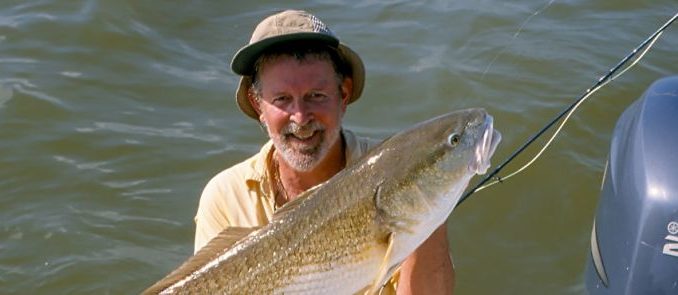
In early July, the fly fishing community suffered a great loss. Pete Cooper Jr. passed away after a courageous bout with cancer. He was 72.
Pete was born in Oklahoma, and grew up in Shreveport. He attended LSU, and in 1967 married his wife, Barbara. Soon after, they moved to Buras where he took a job with Gulf Oil, which later merged with Chevron.
During his time in Baton Rouge, Pete would routinely fish the Amite, Comite, and other sandy creeks, perfecting his fly casting skills. In 1971, while casting poppers to bass in Venice, he hooked up with his first redfish on a fly rod.
It was an instant addiction — and Pete felt compelled to write about it.
At first it was the local newspaper. Soon it was magazine articles. By the time I first met Pete in 1988, he had written well over a hundred articles. Incredibly, he would go on to write over a thousand.
A few of the publications included Saltwater Sportsman, Saltwater Fly Fishing, Gulf Coast Fisherman, Louisiana Conservationist and Louisiana Sportsman. In fact, Pete was the original Fly Lines columnist.
Later, he wrote the first book on fly fishing in Louisiana entitled, “Fly Fishing the Louisiana Coast.” His later books were: “A Paradise Lost,” “The Fine Art of Creek Fishing,” “Redfish: All You Need to Know,” and “Fly Fish for Specks.”
While Pete will forever be known as the “Father of Louisiana Saltwater Fly Fishing,” he loved fishing ponds and creeks. He also enjoyed fishing Missouri streams for smallmouth bass. His innate ability with the long rod made him a threat to all species.
Pete made many other contributions to our sport. He created nearly a dozen fly patterns, including the Perch Float Popper and the Golden Rule. He helped establish the state fly rod records, and placed a large number of fish in those books. And he was a frequent speaker at events across the South.
He was most proud of his participation in the Gulf States Marine Fisheries Commission management plans for flounder, striped bass and tripletail.
For his written contributions to fishing, fly fishing, and hunting, he was inducted into the Louisiana Sportsmens Hall of Fame in 2003.
It’s said that if you wish to get the measure of a man, count his friends. Pete had more than anybody I knew. I was lucky to be one.
There’s so much more I could say about my mentor. But I know what Pete would say. He’d say, “Cormier, quit talking about me. Tell your folks about this great fall marsh fishing coming up.”
So to honor Pete, I’ll share some of his wisdom on fall redfish.
He would suggest first looking for grass. Lush aquatic vegetation provides excellent cover for a redfish looking for an easy meal.
Furthermore, submerged grass serves as an excellent filter, keeping water clear and allowing for excellent sight-fishing opportunities.
Find a grass bed that has an abrupt edge (no grass). This is where the bigger fish will feed. Downwind edges are best as they create a zone of flat water where fish can be detected.
Outside of grass, find structure. Oyster beds will hold fish — as will spots where pipes and pilings have generated shell bottoms. These are good blind casting spots.
Pete’s favorite fly was a popper. A popper will entice fish to move outside their comfort zone. Further, it offers the best action on cloudy or windy days when spotting fish is difficult.
When casting a fly to a fish, let the line flow through your non-casting hand. This will allow you to abruptly stop the line if it threatens to overshoot the fish. Lining a red is always a bad thing.
Line placement is something you should work on when practice casting. Many flycasters practice by casting at the fish. Instead, you should cast the fly ahead, and slightly past the trajectory of the fish. In this way, if the fish moves left or right along its path, you’ve got it covered.
Never retrieve a fly toward a fish. If necessary, move to a position where the fly can be retrieved perpendicular to or at an angle away from the fish.
Pete had mixed feelings about casting from a platform. While it’s easier to spot fish, he also believed it’s easier for the fish to spot you. If it’s possible to locate fish while keeping a low profile, do so.
When blind casting for reds, Pete’s favorite flies were size 1 Clousers in purple and chartreuse and size 2 Seaducers in natural colors. Both flies can cover a lot of water and imitate a variety of baitfish.
This is just a small sample of the redfish wisdom of Pete Cooper. If it whets your appetite for more, check out his book, “Redfish: All You Need to Know.”


